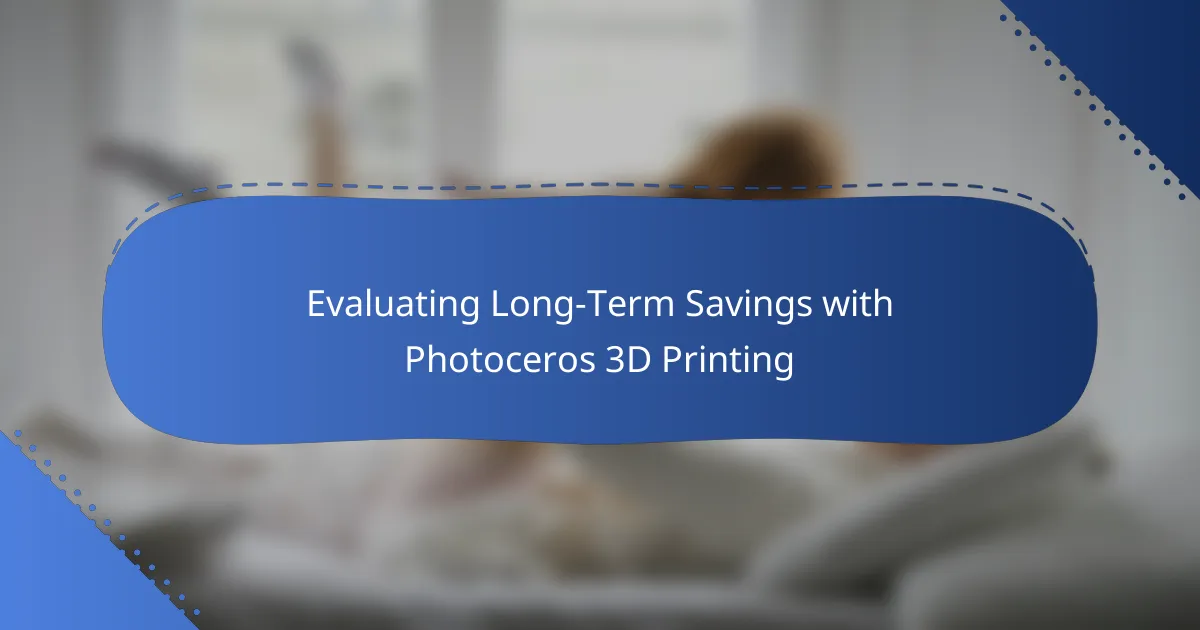Evaluating long-term savings with Photoceros 3D printing reveals its potential to transform manufacturing efficiency. By enhancing material utilization, cutting energy costs, and reducing labor expenses, this innovative technology offers substantial savings over time. Its ability to provide customization and faster production further solidifies its position as a cost-effective solution for various industries.
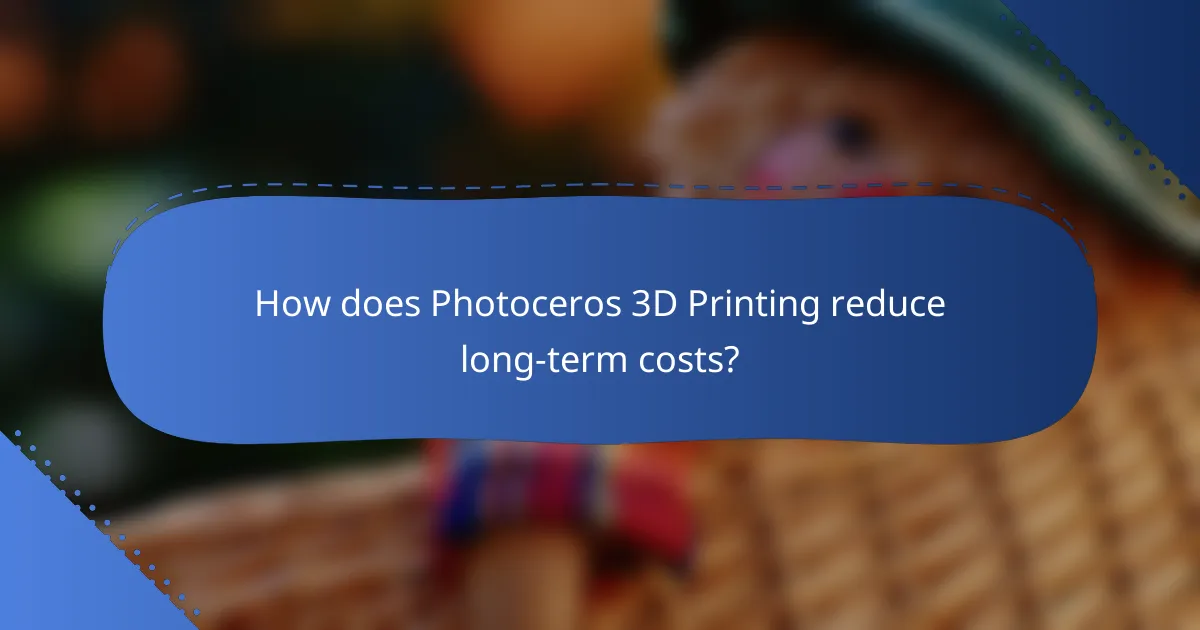
How does Photoceros 3D Printing reduce long-term costs?
Photoceros 3D printing significantly lowers long-term costs by enhancing material efficiency, reducing energy consumption, and minimizing labor expenses. These factors collectively lead to substantial savings over time, making it a cost-effective solution for various manufacturing needs.
Material efficiency
Photoceros 3D printing optimizes material usage by creating precise components with minimal waste. Traditional manufacturing methods often result in excess scrap, whereas 3D printing builds objects layer by layer, using only the necessary amount of material.
This efficiency can lead to savings of up to 30% on raw materials, depending on the design and complexity of the parts being produced. For businesses, this means lower costs for materials and reduced environmental impact.
Energy savings
Energy consumption is a critical factor in long-term savings, and Photoceros 3D printing is designed to be energy-efficient. The technology typically requires less energy compared to conventional manufacturing processes, which often involve multiple stages and machinery.
By utilizing advanced printing techniques, companies can see energy savings of around 20-40%. This reduction not only lowers operational costs but also contributes to a smaller carbon footprint, aligning with sustainability goals.
Reduced labor costs
With Photoceros 3D printing, the need for extensive manual labor is significantly decreased. Automated processes streamline production, allowing fewer workers to manage the entire operation effectively.
Businesses can save on labor costs by reducing staffing needs and minimizing training expenses. This shift can lead to savings of 15-25% in labor-related expenditures, making it an attractive option for manufacturers looking to improve their bottom line.

What are the key benefits of using Photoceros 3D Printing?
Photoceros 3D Printing offers several key benefits, including enhanced customization, quicker production times, and significant waste reduction. These advantages make it a compelling choice for businesses looking to optimize their manufacturing processes.
Customization capabilities
Photoceros 3D Printing excels in customization, allowing businesses to create unique products tailored to specific customer needs. This technology enables the production of intricate designs and personalized items that traditional manufacturing methods cannot easily achieve.
For instance, companies can produce custom prototypes or small batches of specialized products without the high costs associated with traditional tooling. This flexibility can lead to increased customer satisfaction and loyalty.
Faster production times
One of the standout benefits of Photoceros 3D Printing is its ability to significantly reduce production times. While traditional manufacturing can take weeks or even months, 3D printing can produce items in a matter of hours or days, depending on complexity.
This rapid turnaround allows businesses to respond quickly to market demands or changes in customer preferences. For example, a company can quickly iterate on a design based on feedback, ensuring they stay competitive in their industry.
Waste reduction
Photoceros 3D Printing contributes to waste reduction by using only the material necessary for each product, minimizing excess. Traditional manufacturing often involves cutting away large amounts of material, leading to significant waste.
By adopting 3D printing, businesses can not only lower their material costs but also reduce their environmental impact. This approach aligns with sustainable practices, appealing to eco-conscious consumers and stakeholders.
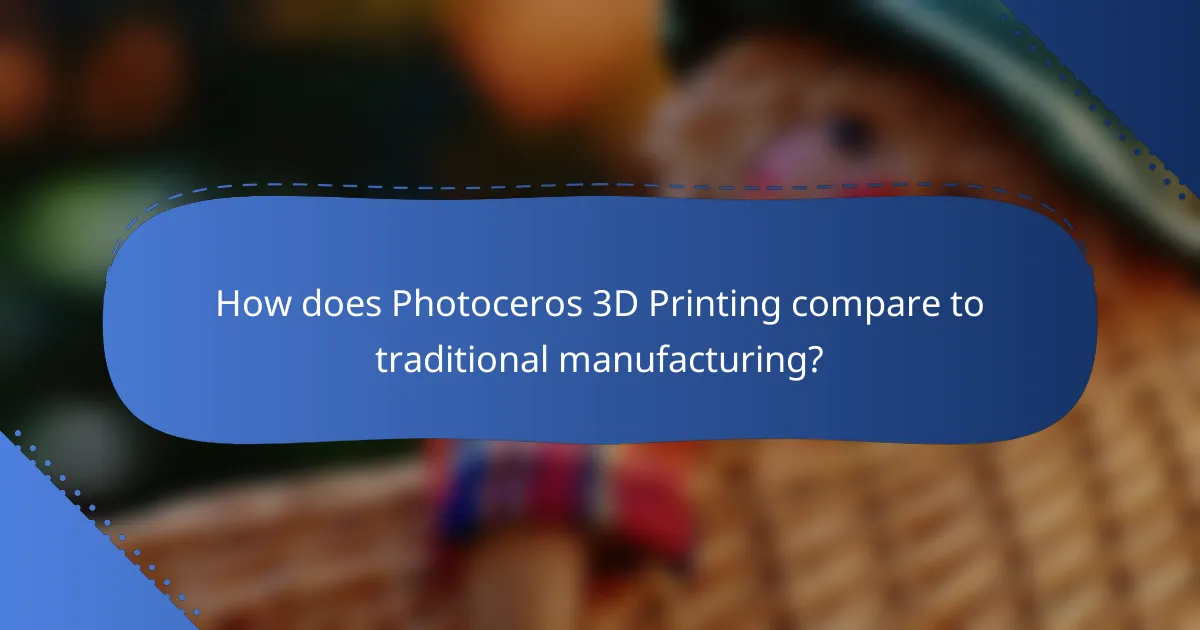
How does Photoceros 3D Printing compare to traditional manufacturing?
Photoceros 3D printing offers significant advantages over traditional manufacturing methods, particularly in terms of cost, scalability, and quality. By utilizing advanced technology, it can reduce material waste and production time, making it a compelling choice for many businesses.
Cost comparison
When comparing costs, Photoceros 3D printing generally requires lower initial investment and operational expenses than traditional manufacturing. While traditional methods often involve high tooling costs and extensive labor, 3D printing minimizes these by using digital designs and automated processes.
For example, producing a prototype with traditional manufacturing might cost hundreds to thousands of dollars, whereas 3D printing can often achieve similar results for a fraction of that cost, sometimes in the low hundreds or even less. This cost efficiency can be particularly beneficial for small businesses or startups.
Production scalability
Photoceros 3D printing excels in scalability, allowing for easy adjustments in production volume. Unlike traditional manufacturing, which may require new molds or extensive setup for increased production, 3D printing can quickly adapt to changes in demand without significant delays or costs.
This flexibility means that businesses can produce small batches or scale up to larger quantities as needed, making it ideal for custom orders or rapid prototyping. Companies can efficiently transition from low-volume production to mass production without the usual constraints of traditional methods.
Quality consistency
Quality consistency is a critical factor where Photoceros 3D printing shines. The precision of 3D printing technology ensures that each item produced meets the same specifications, reducing variability often seen in traditional manufacturing processes.
With traditional methods, factors such as human error or machine calibration can lead to inconsistencies in product quality. In contrast, 3D printing maintains high standards, often achieving tolerances within low millimeters, which is essential for industries requiring strict quality control, such as aerospace or medical devices.

What factors should be considered when evaluating Photoceros 3D Printing?
When evaluating Photoceros 3D printing, consider the initial investment, ongoing maintenance costs, and material selection. These factors significantly influence the overall cost-effectiveness and efficiency of your 3D printing operations.
Initial investment
The initial investment in Photoceros 3D printing includes the cost of the printer, software, and any necessary accessories. Prices can vary widely, typically ranging from a few thousand to tens of thousands of dollars depending on the model and capabilities.
Evaluate your budget and the specific features you need, such as print size and resolution. It’s essential to balance upfront costs with expected output quality and production volume to ensure a worthwhile investment.
Maintenance costs
Maintenance costs for Photoceros 3D printers can include regular servicing, replacement parts, and software updates. These expenses can accumulate over time, so it’s crucial to factor them into your long-term budget.
Routine maintenance may involve cleaning, calibrating, and occasionally replacing components like lasers or build plates. Setting aside a percentage of your initial investment for maintenance can help manage these ongoing costs effectively.
Material selection
Material selection is vital in Photoceros 3D printing, as different materials can affect both the quality of the final product and the overall cost. Common materials include various resins, which can range in price and properties.
Consider the specific requirements of your projects, such as durability, flexibility, and finish. Researching material options and their costs can help you make informed decisions that align with your production goals and budget constraints.
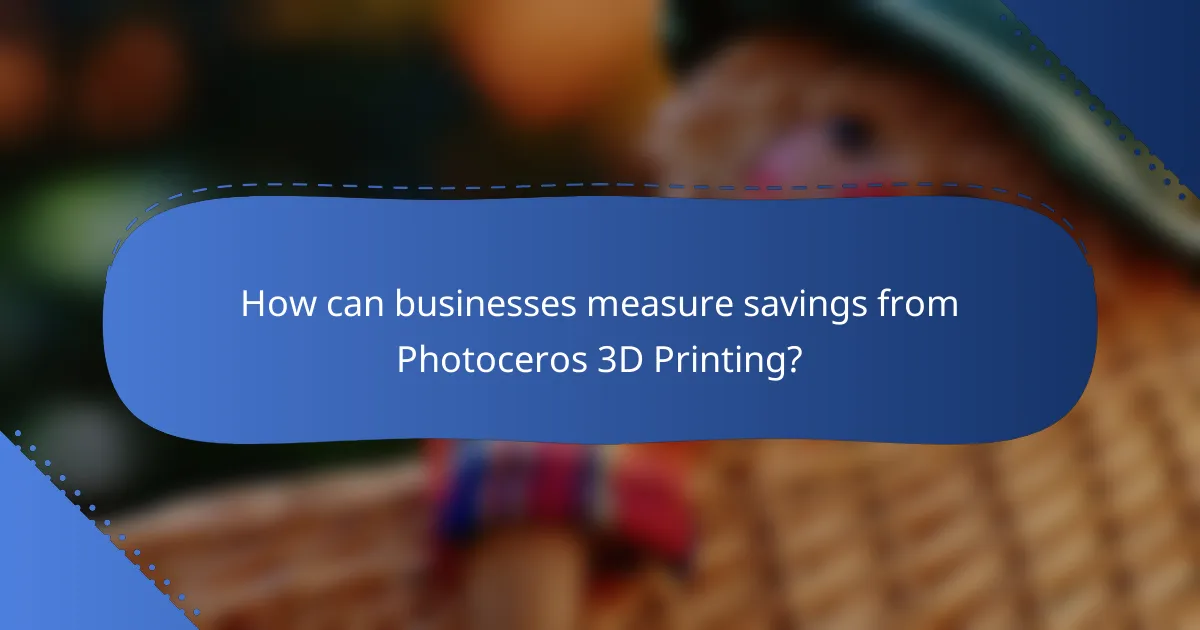
How can businesses measure savings from Photoceros 3D Printing?
Businesses can measure savings from Photoceros 3D Printing by conducting a thorough evaluation of costs versus benefits. This involves analyzing direct expenses, time savings, and the potential for increased revenue generated through enhanced product offerings.
Cost-benefit analysis
A cost-benefit analysis for Photoceros 3D Printing involves comparing the total costs of implementing the technology against the financial gains it brings. Key factors to consider include material costs, operational expenses, and labor savings. Businesses should also factor in the reduction of waste and the ability to produce complex designs that may not be feasible with traditional manufacturing methods.
To perform this analysis effectively, create a detailed list of all associated costs and expected benefits. This can help in visualizing the financial impact and making informed decisions about investment in 3D printing technology.
Return on investment (ROI)
Calculating the return on investment (ROI) for Photoceros 3D Printing requires assessing the net profit generated from the technology relative to its costs. A positive ROI indicates that the benefits outweigh the initial and ongoing expenses. Typically, businesses aim for an ROI that is significantly above zero, ideally in the range of 20-30% or more within the first few years.
To calculate ROI, use the formula: (Net Profit / Cost of Investment) x 100. This will provide a clear percentage that reflects the financial return from the investment in 3D printing capabilities.
Long-term financial projections
Long-term financial projections for Photoceros 3D Printing should consider not just immediate savings but also future growth opportunities. Businesses can project savings over a period of several years by estimating increased production capacity, market expansion, and potential cost reductions as technology improves.
When creating these projections, consider factors such as market trends, technological advancements, and potential changes in material costs. Regularly updating these projections can help businesses stay aligned with their financial goals and adjust strategies as needed.
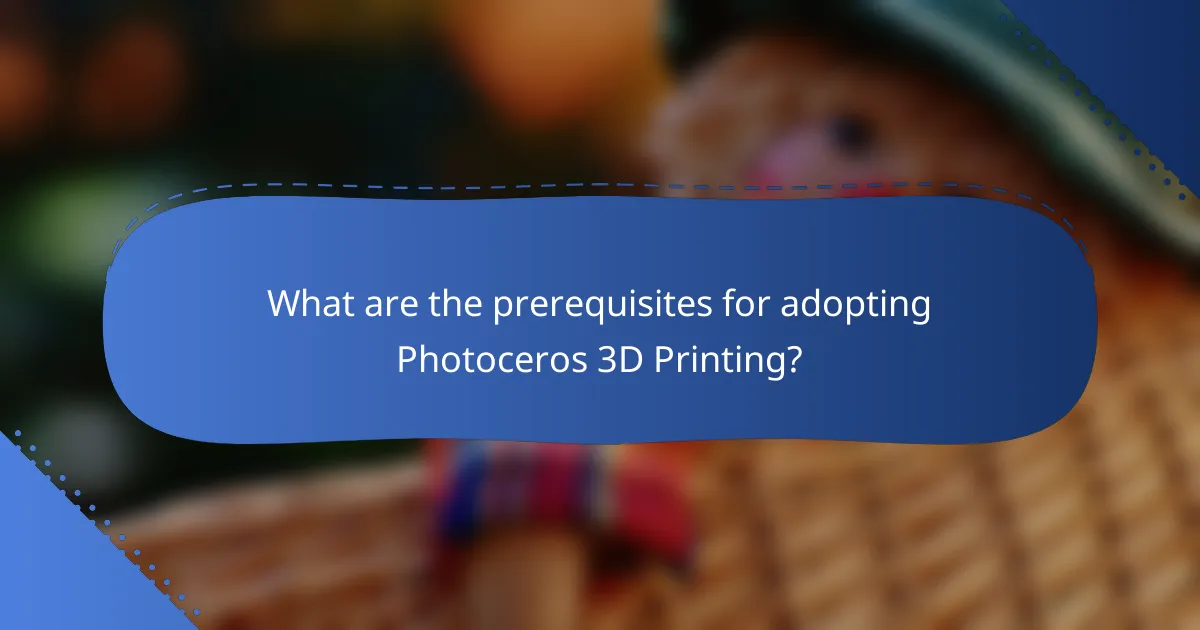
What are the prerequisites for adopting Photoceros 3D Printing?
Adopting Photoceros 3D Printing requires specific prerequisites that ensure successful implementation and operation. Key factors include technical expertise, adequate infrastructure, and necessary adjustments to the supply chain.
Technical expertise
To effectively utilize Photoceros 3D Printing, a solid understanding of 3D modeling and printing technologies is essential. Personnel should be trained in software used for designing models and operating the printers, which may involve specialized courses or certifications.
Additionally, familiarity with troubleshooting common issues that arise during the printing process can significantly enhance productivity. Companies should consider hiring or training staff with backgrounds in engineering or design to bridge any knowledge gaps.
Infrastructure requirements
Implementing Photoceros 3D Printing necessitates specific infrastructure, including adequate workspace and equipment. A dedicated area for the printers should be well-ventilated and equipped with necessary utilities such as power and internet access.
Moreover, investment in supporting tools like post-processing equipment and storage for materials is crucial. Companies should assess their current facilities and determine if renovations or expansions are needed to accommodate these requirements.
Supply chain adjustments
Transitioning to Photoceros 3D Printing may require modifications to existing supply chains. Businesses should evaluate their material sourcing strategies to ensure compatibility with the 3D printing process, which often uses specialized resins and filaments.
Establishing relationships with reliable suppliers who can deliver high-quality materials on time is vital. Additionally, companies should consider integrating just-in-time manufacturing practices to optimize inventory management and reduce waste.
